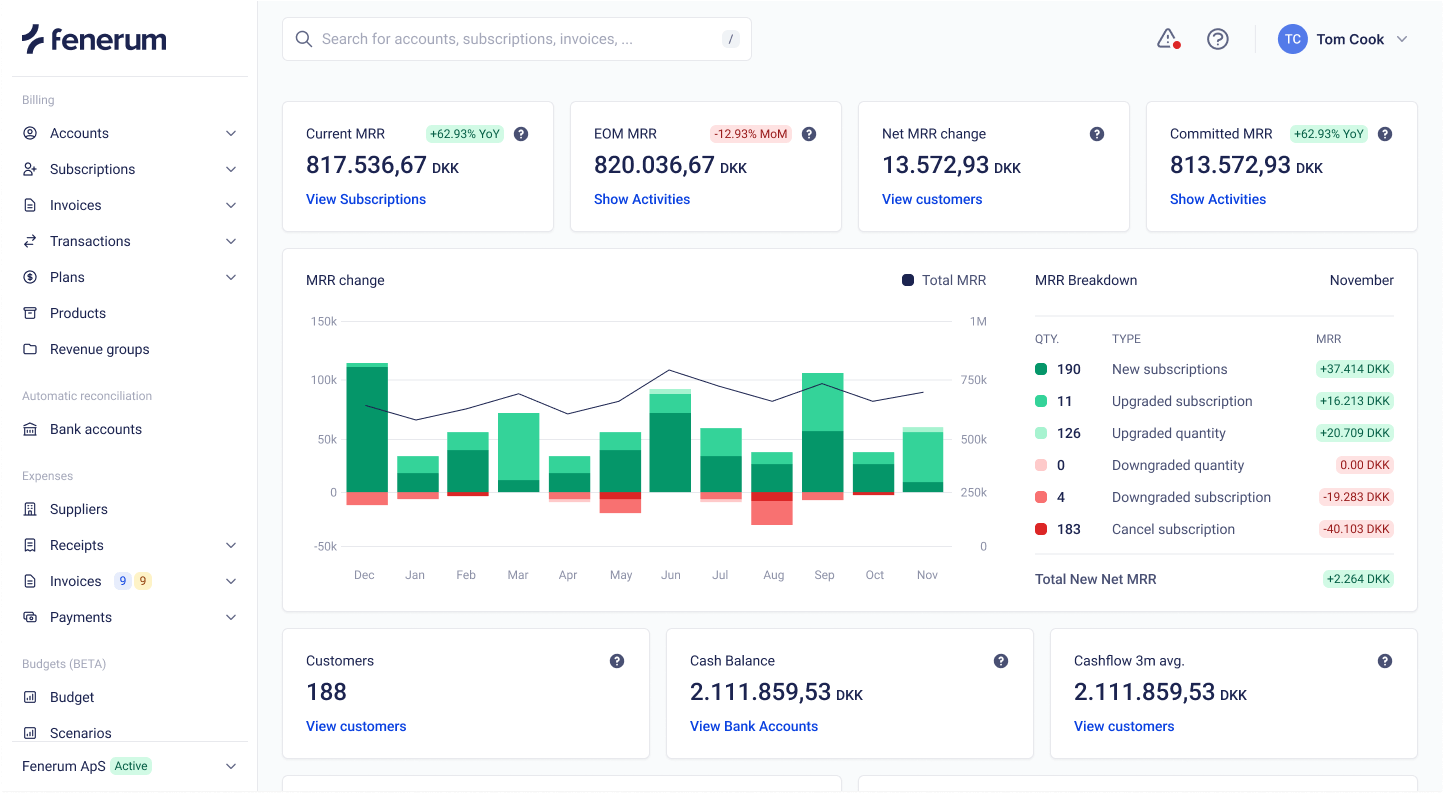What is MRR in SaaS?
Monthly Recurring Revenue (MRR) is a key metric for any SaaS business, representing the predictable revenue generated from subscriptions on a monthly basis. For B2B SaaS companies, MRR offers a snapshot of financial performance, helping to forecast future revenue and plan for growth.
Why is MRR Important?
MRR SaaS is important because it provides a consistent and reliable measure of a company's revenue stream. This metric is invaluable for:
- Financial Forecasting: Predicting future revenue and growth.
- Investor Relations: Demonstrating the stability and potential of your business.
- Performance Tracking: Monitoring the effectiveness of sales and marketing strategies.
However, MRR in SaaS does not consist of just one number - it depends on multiple factors related to your subscription business:
- New MRR: Revenue generated from new customers.
- Net New MRR: The growth or decline in revenue compared to the previous month.
- Expansion MRR: Revenue from contract upsells, cross-sells, and add-ons.
- Upgrade MRR: Revenue from subscriptions upgraded to a higher pricing tier.
- Contraction MRR: Revenue lost due to discounts etc.
- Downgrade MRR: Reduced revenue from subscriptions downgraded to a lower pricing tier.
- Reactivation MRR: Revenue from churned customers who returned to a paid plan.
- Churn MRR: Revenue lost due to subscription cancellations from month to month.
 Fenerum dashboard showing SaaS metrics and MRR Breakdown.
Fenerum dashboard showing SaaS metrics and MRR Breakdown.
How to Calculate MRR SaaS
Calculating MRR is straightforward but requires careful attention to detail. Here’s how to break it down:
- Identify Active Customers: Determine the number of paying customers for the month.
- Calculate Average Revenue Per User (ARPU): Divide the total revenue by the number of customers.
- Multiply: Multiply the number of active customers by the ARPU.
Example Calculation
Suppose you have 100 customers each paying $50 per month. Your MRR SaaS would be:
MRR = 100 customers x $50 per customer = $5000
Enhancing Your MRR SaaS
Improving your MRR is a multifaceted process that involves enhancing customer acquisition, reducing churn, and optimizing pricing strategies. Here are some effective ways to boost your MRR:
Customer Acquisition
Targeted Marketing: Implement targeted marketing campaigns to attract high-quality leads. Utilize SEO, content marketing, and social media to reach your audience effectively.
Sales Strategies: Optimize your sales process to convert more leads into paying customers. Train your sales team to understand customer needs and offer solutions that add value.
Reducing Churn
Customer Support: Provide excellent customer support to retain existing customers. Happy customers are more likely to renew their subscriptions and recommend your service to others.
Engagement: Keep your customers engaged with regular updates, newsletters, and personalized communication. Use data analytics to understand customer behavior and preferences.
Pricing Optimization
Flexible Pricing Plans: Offer flexible pricing plans to cater to different customer segments. Consider tiered pricing, freemium models, and enterprise solutions to maximize your reach.
Value-Based Pricing: Align your pricing with the value provided to the customer. Understand what features are most valuable to your users and price accordingly.
Leveraging SaaS Billing Solutions
Efficient SaaS billing solutions are crucial for B2B subscription management and ensuring accurate revenue tracking. These solutions automate billing processes, handle various pricing models, and provide detailed analytics. Implementing a robust billing system can significantly reduce administrative overhead and improve cash flow management. Some popular B2B subscription management tools in 2024 includes Fenerum, Stripe Billing and Younium.
Monitoring Subscription Metrics
Beyond MRR SaaS, several other subscription metrics are essential for a holistic view of your business performance. These include:
- Customer Lifetime Value (CLV): The total revenue expected from a customer over their entire relationship with your company.
- Churn Rate: The percentage of customers who cancel their subscriptions within a given period.
- Customer Acquisition Cost (CAC): The cost associated with acquiring a new customer.
Monitoring these metrics alongside MRR provides deeper insights into your business's health and areas for improvement.
Conclusion
MRR SaaS is a vital metric for any subscription-based business, offering a clear and consistent measure of revenue. By understanding how to calculate and improve MRR, leveraging SaaS billing solutions, and monitoring key subscription metrics, you can drive growth and ensure the long-term success of your business. Focus on enhancing customer acquisition, reducing churn, and optimizing pricing strategies to see a significant boost in your Monthly Recurring Revenue. Keep an eye on the broader picture with comprehensive subscription metrics to stay ahead in the competitive SaaS landscape.
For more insights and solutions tailored to your SaaS business needs, read more about Fenerum.
30 May 2024, By: Fenerum
